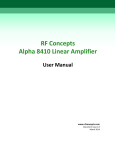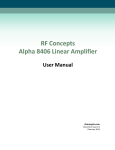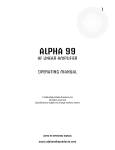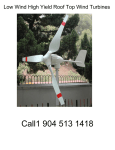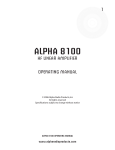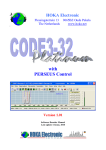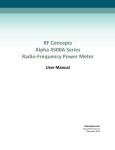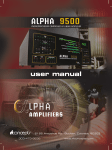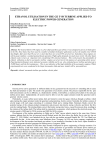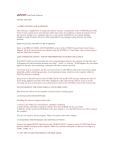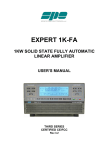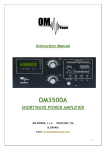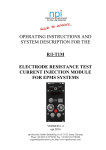Download Manual
Transcript
Preliminary ALPHA 8406 6 Meter VHF LINEAR AMPLIFIER OPERATING MANUAL © 2010 RF Concepts, Inc 634 S Sunset St Longmont, Colorado 80501 Phone 303 4739232 All rights reserved Specifications subject to change without notice - Rev. 1.2 December, 2010 1 Index Specifications 3 Introduction 5 Quick Start Information 9 Station Engineering Considerations 11 Unpacking and Preparation 19 Theory of Operation 27 Operations and Maintenance 31 Trouble Shooting Hints 41 Glossary 45 2 Specifications 8406 6 Meter Amplifier Frequency Input drive Level Power Output SWR Tolerance Duty Cycle Tubes Inter Modulation Level Harmonics Mode of Operation Input AC Voltage AC Current Input Impedance Output Impedance RF Connectors Cooling Size Weight T/R Relay Tuning Display Interface Protection RF Bypass Level 50-54 MHz 50 Watts Nominal 1500 watts 3:1 100 % (4CX1500B) 34 dB minimum, Two Exciter -72 dBc CW, SSB, FM 100-240 Selectable <13 5mps @240 VAC @1500 watts 50 Ohms 50 Ohms “N” Female Forced Air 17.3” W x 7”H x 21.0”D Including Fan Space 70 lbs., 31.8 kg Vacuum QSK Manual Bargraph LED USB Against all common faults Less than 200 watts This amplifier meets or exceeds all technical specifications listed above. 3 4 1 Introduction 1.1 General Description Congratulations on your purchase of a professional quality Alpha 8406 amplifier! With proper installation and care, you can expect to enjoy your Amateur Radio hobby with this amplifier improving your signal for many years to come. Please study this manual carefully before operating your amplifier for the first time. The Alpha 8406 is a self-contained manual tune VHF linear power amplifier capable of continuous operation at 1500 W peak power output on SSB, keyed CW, SSTV, RTTY, digital modes or FM, with no time limit. See our web site at www.rfconcepts.com or call 303-473-9232 for further information. 1.2 Amplifier Capabilities CAUTION: It is extremely important to thoroughly review the Installation and Operation sections of this manual before attempting to us the Alpha 8406. Failure to do so could result in serious damage that may not be covered under warranty. Continuous RF Output. The 8406 is capable of 1.5 kW continuous RF output on all commonly used modes and on any authorized amateur frequency from 50-54 MHz Compatibility with popular amateur transceivers and exciters. The 8406 requires approximately 50-65 W peak RF drive for 1.5 kW output. Capable of full CW break-in, QSK and all digital modes when used with any appropriate transceiver. Protective functions are built in. The control system incorporates protective functions that minimize the probability of accidental damage to the amplifier or its power tubes. In most cases, when one of the protective functions is “tripped,” the amplifier will go to Standby. 1.3 Shipping Information The Alpha 8406 amplifier ships in two heavy-duty double cardboard cartons. One carton 5 holds the power transformer and weighs 43 lb (20 kg) and the second carton contains the amplifier and weighs 50 lb.(17 kg). Alpha recommends that you retain the cartons after installation in the unlikely situation that you need to ship the unit later. Contact RF Concepts at 303-473-9232 for shipping advice and assistance. 1.4 Safety Information – Installation and Operation Make sure the Alpha 8406 is located where there is good air circulation all around and on top of the cabinet. The unit may become hot during operation. The Alpha 8406 weighs approximately 70 pounds when the transformer is installed. Use proper lifting techniques and two people when moving the amplifier. Note that amplifier should NEVER be transported with the transformer in place. The Alpha 8406 is designed to meet international safety standards and FCC regulations. However, one should always remember that the equipment works with high voltages that can be LETHAL! This operating manual holds information, cautions and warnings that must be followed to ensure safe installation and operation. Read Chapter 1 before attempting to unpack or operate the Alpha 8406 amplifier. Warnings: What Not to Do Never open the amplifier case without unplugging the unit from the wall outlet. Always resist the temptation to immediately hit the ON button after the amplifier faults to power off. Never touch an antenna during transmission. Never attempt to turn on the amplifier without the cover securely in place (all attachment screws reinserted). Never turn the amplifier back on after a hard fault without waiting at least 20 seconds. Never allow liquids to enter the amplifier through the cover holes. Never stick objects into holes in the case. Warnings posted in this manual should be read and thoroughly understood by users. Failure to perform procedures properly may result in amplifier damage, fire hazard, or electric shock. 1.5 Owner Assistance Technical Assistance from RF Concepts is available from several sources. 6 The RF Concepts web site is www.rfconcepts.com. Click on Support and follow the instructions. Many typical problems and their solutions are listed on this site. On this site you can get the following assistance: Technical Support Repair Information Software Downloads Manuals Tech Tips Legacy Equipment Information FAQ’s Alpha Forum You can email us for customer support by filling in the support request at www.rfconcepts.com or you can send your request by fax to 303-473-9660, or call us at 303-473-9232 7 8 2 Quick Start Information 2.1 Overview This section explains in brief the items you need to consider when setting up your Alpha 8406 amplifier. If you already have a well-designed shack and have used an amplifier before, please review the items below to make sure you have considered all the critical items for proper installation and operation. If you are using an amplifier for the first time, please skip this section and go to sections 3, 4, and 5 for a more detailed explanation of how to set up your shack for maximum safety and operating enjoyment. If you have installation questions, do not hesitate to contact Customer Support. We much prefer to address questions prior to power up. 2.2 Station Engineering Considerations - Checklist Make sure you have properly addressed the following concerns (Section 2.3 below) before installation of your Alpha 8406 amplifier. If you are unsure of any of these items, please read the noted sections carefully. 2.3 Preparation __ 240V AC Power in shack? (Section 3.2) __ Amplifier placed with proper airflow? (Section 3.3) __ Antenna ready for 1,500W? (Section 3.4) __ Adequate RF cabling? (Section 3.5) __ RF Exposure Safety (Section 3.6) 2.4 Unpacking 9 __ Unit Checked for Damage? __ Transformer Installed? (Section 4.2.1, 4.2.2) __ Power Cord Connector Attached? (Section 4.2.3) __ AC Primary Voltage Set? (Section 4.3.6) ___Amplifier Grounded Properly? (Section 4.4.1) __ Amplifier Cover Replaced and Secured? (Section 4.3.6) 2.5 Operation __ All Exciter Interconnections Set? (Section 6.2) __ Exciter Drive Correctly Set? (Section 6.1.1) __ Amplifier Tuned to Antenna System? (Section 6.3.6) 10 3 Station Engineering Considerations 3.1 Overview The Alpha 8406 is capable of dramatically improving the performance of your amateur station. It is important that you observe good engineering practices to achieve all the benefits of such a station in a safe and reliable manner. This section provides a few hints for important operational considerations, but it is recommended that the user also consult a good source of general information such as “The Radio Amateur’s Handbook” by the ARRL, especially if this is the first high-power amplifier you have used. 3.2 AC Power Source This amplifier runs best when powered by a 200V - 240V AC circuit. If you do not have a 240V AC outlet in your shack, you will need to get a licensed electrical contractor to install one. A minimum of a 20 amp capacity is required. A 20 amp breaker on your 240V circuit is sufficient. There are many styles of plugs, some of which are countryspecific. For this reason, the amplifier is not shipped with a power plug. Select a location for the outlet as close as possible to where you expect to operate the 8406. If you are not sure, or contemplate moving the amplifier, you may choose to get a second outlet installed at the same time. Ask your contractor for two or three matching plugs during installation as there are several styles of connector available. Ask the contractor to measure the voltage and record it, so you can set the line voltage tap on the 8406 appropriately. If possible, have the contractor measure the line voltage with a 10 amp current draw, and use this value for setting the transformer tap. The Alpha 8406 can run when connected to a 120V AC outlet. However, you WILL NOT achieve full legal limit output in this case. If the amplifier is connected to a 120V AC outlet, you should not expect more than 1000 W output. 3.3 Air Flow 11 It is critical that airflow around the Alpha 8406 remain unimpeded at all times. Keep the top of the amplifier clear of any restrictions. If you are mounting the amplifier in a console, make sure that the exhaust air is properly and fully removed from the console. Figure 3.3 -Minimum clearance for proper airflow Keep top tube exhaust clear Keep rear intake clear Poorly designed consoles can result in outlet air being drawn back into the amplifier air intake and recirculated, thus getting hotter and hotter and resulting in degraded amplifier performance or even failure. If you are designing your own console, consider putting in additional fans and/or ducting to deal with waste heat. Try to minimize the possibility of dust or other contamination getting drawn into or falling on the amplifier. It is also advisable to periodically (at least annually) clean the dust out of your amplifier for continued flawless operation. RF Concepts recommends the use of compressed air for dust removal. Too ensure adequate cooling, make sure the top and rear of your amplifier have at least 3” of clearance to allow unobstructed airflow. Make sure the exhausted air cannot be recirculated back into the amplifier air intake. 12 3.4 Antennas Many antennas that are suitable for general use are unsuited for operation with a full 1500 W of power. At this power level in a 50-ohm circuit, the RMS current is 5.5 amps and the peak RF voltage is 387 volts. With a 2:1 SWR, these values double to 11 amps and 775 volts. The actual voltage and current at various points in or on your antenna may actually be many times these values. On a simple dipole with sharp wire ends, corona (localized ionization) can easily occur. Corona can (and has!) led to fire in nearby objects. Traps in beams and verticals can heat up significantly during high power operation. Instances of melting or flashover of traps have occurred in many installations where insufficient thought has been given to their ratings. If an antenna has been deployed for a long period of time, it may be worth taking it down for inspection prior to full power operation. 3.5 Coax and Connectors The importance of a well-constructed feed-line system cannot be overstated. After all, the purpose of the amplifier is to provide approximately 2 S units (12+ dB) of improvement in your radiated signal. All too often, installation problems are encountered where cheap, poor or under-rated coax and connectors are used. These often are responsible for at least one S unit of degradation. (This means you could have bought a 375 W amplifier and achieved the same radiated signal by buying good quality feed-line components!) Use the lowest loss 50-ohm coaxial cable you can obtain. Use new, clean connectors installed according to the manufacturer’s recommendation. Clean the connectors after soldering them, and before mating them with the amplifier. Make sure any excess solder is removed from the connector; likewise remove any fragments of braid etc. Never use old coax, which may have had moisture penetrate under the jacket. Support the coax frequently using non-compressive clips so that it does not hang or stretch under its own weight. Avoid sharp or kinked bends (most manufacturers will specify a minimum bend radius for their product). Make sure the connection from feed-line to antenna is waterproof. Provide for disconnection of the feed-line when it is not in use; this protects against damage caused by power surges and lightning strikes, which are not covered under the amplifier warranty. 3.6 RF Safety 13 The FCC requires users to check their installations for compliance with published values for allowable exposure to RF fields. This information is available in ARRL publications, FCC printed rules, and on the web. RF Concepts strongly recommends that this be done for any installation, both fixed and at an expedition or contest site. If you have any questions regarding engineering your 8406 into your amateur radio station, please visit our online technical support website at: www.rfconcepts.com The below calculations are taken with the RF Exposure calculator located at http://hintlink.com/power_density.php. Three representative calculations are presented below. Two safe distances are represented. The first is a controlled area. A controlled area, is where a person knows the radiation levels and exactly how long they can be in the area before having to leave the area for a specific period of time. The second is an uncontrolled area. An uncontrolled area is generally where pedestrians may not know they are in an exposure area and as a result this area the radiation levels must be below a point where a person may remain indefinitely. ¼ Wave Vertical Antenna 14 Cal cul ati on Re sul ts Interpretation of Results 1. The power value entered into these calculations should be the average power seen at the antenna and not Peak Envelope Power (PEP). You should also consider feedline loss in calculating your average power at the antenna. 2. If you wish to estimate the power density at a point below the main lobe of a directional antenna, and if the antenna's vertical pattern is known, recalculate using the antenna's gain in the relevant direction. 3. Please also consult FCC OET Bulletin 65 Supplement B, the Amateur Radio supplement to FCC OET Bulletin 65. It contains a thorough discussion of the RF Safety regulations as they apply to amateur stations and contains numerous charts, tables, worksheets and other data to help determine station compliance. Av era ge Po we r at the An ten na The above calculation is for a vertical ground plane antenna at 20 feet elevation feed 150 with a short piece of coax with the station located just below the antenna. Minimum 0 safe distance is represented in Red. The antenna is located at ten feet above ground. wa tts An ten na 6 Element Beam at 100 Feet Ga in in dB i 2 dBi Dis tan ce to the Ar ea of Int ere st 100 15 feet 30. 48 met ers Fre Av era ge Po we r at the An ten na 140 0 wat ts An ten na Ga in in dB i -10 dBi The above calculation represents a 1400 watt RF signal feed into a 6 element yagi Dis located 100 feet above the ground. As a result the down ward lobe 100 feet from the tan base of the tower is at a 45 degree angle. The RF measured is out of the main lobe ce and as a result the antenna has a negative 10 dB of gain over the normal 12 dBi gain to if the person was standing in the main pattern lobe. the Ar ea of Int ere st 100 feet 30. 48 met ers Fre qu enc y of Op era tio n 16 3 Element Beam at 35 feet Average Power at the Antenna 1400 watts Antenna Gain in dBi 5 dBi Distance to the Area of Interest 100 feet 30.48 metres Frequency of Operation 50 MHz Are Ground Reflections Calculated? Yes Estimated RF Power Density 0.0613 mW/cm2 Controlled Uncontrolled Environment Environment Maximum Permissible Exposure (MPE) 1.005 mW/cm2 Distance to Compliance 24.7994 feet From Centre of Antenna 7.5589 meters Does the Area of Interest Appear to be in Compliance? yes 0.205 mW/cm2 55.3913 feet 16.8833 meters yes The above calculation represents a four element beam at 35 feet above the ground feed with 1400 watts of power. At 100 feet most of the pattern gain is still over the person standing at 100 feet. 17 18 4 Unpacking & Preparation 4.1 Unpacking Inspect both boxes for physical damage. Save all packing material for possible future use. Contact 303-473-9232 if shipping damage is found. Carefully unpack the amplifier and transformer. Carefully remove the amplifier and place it on a workbench or table where you can install the power transformer. 4.2 Installing the Power Transformer It is recommended that the power transformer be installed when the amp is at or near the place it is to be used. The chassis of the 8406 is designed for the mechanical loads it experiences when the amplifier is on a flat surface with the tilt-bail up or down. If the amplifier is tilted too far, such that the transformer is cantilevered or “hanging out” to any degree, the chassis of the amplifier can distort. If the amplifier is moved, even if only from one site to another locally, remove the transformer to avoid the possibility of damage. CAUTION: Do not operate amplifier without the cover in place and all cover screws installed. Do not operate the amplifier without a good ground connection on the rear panel ground terminal. Make sure all RF cables have a solid ground shield in place. WARNING! The transformer is very heavy and must be moved with due caution using only the lifting handle. CAUTION: PROCEED SLOWLY to avoid bumping and damaging adjacent wires, connectors or components. While the top cover is removed, make the tube is firmly seated in its socket, rubber exhaust chimney is fully and correctly installed, and anode connector is tightly clamped 19 to the tube. The silicone rubber chimney installed on the 4CX1500B tube is a critical part of the cooling system. Make sure the chimney is straight and fully installed so the bottom of the chimney is firmly against the tube deck and completely covers the airflow openings in the deck. Make sure that the silicone rubber chimney is flush with the top cover when it is placed back on the amplifier. Tube cooling exhaust must exit only through the tube anode fins; it must not be allowed to escape outside them. Failure to ensure proper cooling airflow may result in tube damage or destruction, which is not covered under warranty. 4.2.2 Connecting the Transformer Power Plugs Connect the 9-pin white Molex connector to the matching plug mounted on the back wall of the amplifier Connect the 8-pin orange connector to the matching pins on the upper (Mains) PCB. Connect the 6-pin yellow connector to the matching pins on the lower (HV) PCB Check to ensure that all connector pins on these three connectors engage fully and correctly. 4.2.3 Power Cord Connections WARNING! To avoid the hazard of a potentially fatal electric shock and/or severe damage to the ALPHA 8406 and other equipment, always use an AC plug that is appropriate for the primary mains voltage, current rating and configuration. NEVER use 120V-type plugs and power receptacles for 190-250V circuits. ALWAYS use grounding type AC connectors which conform to local codes and ensure that the green wire in the Alpha 8406 power cable is wired only to the AC mains safety ground (or to neutral, as may be necessary with a 240V circuit configured 120V-N-120V without a separate ground, commonly found in the US). The green conductor in the power cord is wired to the ALPHA 8406 chassis. It MUST be connected only to the power source safety ground or neutral. The black and white power cord wires connect to the two “hot” wires of the AC source; either wire may be connected to either side of the line. For best results use a dedicated 200-240 V branch circuit of #10 AWG copper wire or equivalent, rated at 20 A, to feed the amplifier. 4.2.4 Important Information about Operation from 90-130V AC 20 Electrical power equipment will draw twice as much primary current from 120 V mains as from 240 V mains. Therefore, operating the ALPHA 8406 on a typical 120 V/20 Amp household circuit without exceeding the 20 A circuit rating will limit maximum peak power output to about 600-1000 W. Maximum possible RF output power for any particular primary AC voltage and current capacity may be estimated as: P max = (V x I ) / 2.3 lineline For example, if the Alpha 8406 operates from a circuit that is capable of delivering 120 V AC at a maximum current of 20A, with no other loads connected to the circuit, maximum peak RF output possible without tripping the 20A breaker (or fuse) is approximately: Po max = (120V x 20A) / 2.3 = 2400/2.3 = 1043 W If the same circuit also supplies a transceiver drawing peak line current of 5A and a lamp drawing 1A, only 20-5-1 = 14A is available for the amplifier and maximum possible output is about: Po max = (120V x 14A) /2.3 = 1680/2.3 = 730W Below are some considerations at the high end and the low end of this voltage range that are rarely encountered. Low Voltage vs. Power Output At the low end of the voltage range, do not expect to be able to get 1,500 watts output if your line voltage is below 120 volts. If your line voltage is between 110 and 130 volts, then 1,500 watts PEP operation (CW or SSB) may be possible if your AC line service has sufficient current capacity (30 amp circuit recommended). However, 1,500 watts continuous should not be expected. If your line voltage is between 90-120 volts, then power outputs above 1,000 watts should not be expected from the amplifier. Tune (adjust) the amplifier for no more than 1,000 watts output, and simultaneously for maximum efficiency. Place where normal air flow is not restricted because the cord could overheat. If other equipment is drawing current from the same circuit as the Alpha 8406, then the considerations in section 4.2.3 should be taken into account. High Voltage and Tube Life At the high end (sometimes encountered when using poorly regulated generators) the plate voltage and tube heater voltage may be too high. If voltages above 250 volts are applied for any length of time, the lifetime of the tubes may be reduced. If this is your situation, the first line of defense is to contact your utility company and ask if they can reduce your line voltage. If this is not possible, you may 21 want to consider placing your own step-down transformer in line between the AC outlet and the amplifier. If this is necessary, a transformer with at least 4-kVA rating is required, due to the nature of the current waveform in the primary. Another choice for voltage control, a ferro-resonant voltage regulator, is an expensive solution, but is a good way to stabilize primary voltage. Note: If you intend to operate the amplifier on any of the 90 - 130V settings, the two lower 2 amp fuses on the rear panel will have to be changed to 5 Amp. to allow for the increased in-rush current. RF Input FIGURE 4-2-1 Amplifier Interior 0V 4CX1500B Tube Output Tank Circuit Deck Shielding Output RF Connector Cooling Fan Low Pass Filter Input RF Connector HV Safety Switch AC Transformer Molex Air Inlet Input AC safety Switch RF In Transformer Relay and AC tap PCB RF Out HV AC Transformer 22 Chassis Ground AC Fuses AC Cord FIGURE 4-2-2 Amplifier Rear 23 USB Input Input AC tap settings can be made by moving the flying lead to the marked AC spade posts marked in the appropriate voltages. The proper taps must be made before the AC power is applied. When making changes make sure the amplifier is unplugged. Flying lead attachment points. Figure 4-3 AC Power Setting Never use a tap other than the proper voltage or damage to the tubes and amplifier will result. With the top cover removed, the primary voltage taps are located on the top of the Mains Board, which is between the transformer and the front panel. There is a row of 5 “fast on” connectors (J1 through J5) and a “flying” jumper connector which mates with them. See Figure 4-3 above. There are 5 “nominal” primary voltages, which cover all the line voltages normally encountered around the world. Selecting the appropriate tap for your situation will optimize amplifier performance, safety and lifetime. The nominal mid-range voltage for each tap is printed on the Mains Board circuit board. These voltages are 100,120, 200, 220 and 240 Volts. The acceptable line voltage for each tap is the center voltage plus or minus 10 Volts. One of these taps is suitable for any of the “nominal” line voltages encountered worldwide. CAUTION: When using any high power amplifier, failure to connect ALL station equipment to a good common ground may allow RF feedback to leak 24 into the transceiver and cause severe signal distortion. 4.4.2 Replacing the Amplifier Cover Replace all attachment screws. Use only the 6-32 screws supplied with the amplifier and do not tighten any of the screws until all are started. Do not attempt to operate the amplifier with the cover removed or only placed back on the unit without the attachment screws. This WILL cause damage to the Alpha 8406 and may also lead to injury or death to the operator. 4.5 Amplifier/Station Interconnections Once the power transformer is installed, properly configured, and the cover replaced, place the amplifier in its operating position. The amplifier with the transformer installed is heavy so you may need assistance to safely move it. Make sure it is placed on a stable surface and that there is sufficient space to the rear, sides, and top to allow good air flow and safe placement of cables. 4.5.1 Coaxial Cable Types & Connectors Connect the transceiver RF output to the ALPHA 8406 RF INPUT connector with 50ohm coaxial cable- RG-58C/U or equivalent. Coaxial cable from the 8406 RF OUTPUT connector to the antenna should be RG-8A/U, RG-213/U, or LMR-400. ALC cable is not interconnected when used with a modern transceiver. 4.5.2 T/R Control Cable The Alpha 8406 has a full break-in vacuum relay QSK system requiring only the normal interconnection when used with a modern QSK transceiver. The Alpha 8406 requires a contact closure (short circuit) on transmit from its RELAY jack center pin to chassis. This function is supplied by the transceiver, usually from a dedicated relay that is normally open in receive and closed in transmit. Shielded wire should be used for the T/R control cable. The Alpha 8406 end must be fitted with a common phono (RCA-type) plug and the other end with a connector suitable for the transceiver. The T/R relay contact must close before application of RF drive. Modern transceivers have the proper time delay between key up and the start of the transmitted signal to allow the Alpha 8406 to follow the CW keying. If a T/R timing problem is suspected, connect the CW keyer to the RELAY jack on the Alpha 8406, and connect a cable from KEY OUT on the amplifier to the keying input of the transmitter. 25 4.5.3 ALC The Alpha 8406 does not generate or use ALC voltages to control an exciter. For proper operation the exciter transceiver should have its power output set so as not to over drive the amplifier input. Today’s modern transceivers have very good power output limiting. As a rule ALC is not needed if the transceiver is less than 15 years old. Should your transceiver be older then the power output should be reduced so voice peaks will not overdrive the transmitter under any modulation condition. 26 Theory of Operation 5.1 Theory of Operation - Overview The Alpha 8406 uses a tetrode vacuum power grid tube (4CX1500B) as the amplifying devices. The main power supply is an unregulated transformer/rectifier/capacitor power supply for the high voltage (HV) and heater circuits. All other power supplies are regulated. The control circuit uses a microprocessor “in the loop” to monitor and control amplifier operation. There are 7 circuit cards in the amplifier. In addition to these, the tube, tank circuit assembly, and transformer complete the main sections of the amplifier. These major blocks are described below. The 8406 amplifier includes a 5 V power supply that is mounted behind the front panel. Any time the amplifier is plugged into the mains power, this 5 V supply is active and there is power to the micro-controller on the main control board. This feature allows the amplifier to be turned on or off remotely as well as remote monitoring and debugging though a USB cable connected to a computer. 5.2 Tubes The amplifier is designed to use the 4CX1500B tetrode tube. The amplifier design uses this tube well within ratings. The tube is operated in Class AB1, with a plate voltage of 3,400V (nominal, full output, key down), a grid 1 voltage of -50 to -60 volts, and a grid 2 voltage of +230 volts. The tube has an inductance resistor in series with the cathode. This resistor stabilizes the tube bias and provides negative feedback, which improves linearity (and hence IMD performance). Electronic bias switching (EBS) increases the negative grid 1 voltage in pauses in speech or between Morse code elements. This reduces the standing bias on the tube, resulting in less waste heat, longer tube life and higher overall amplifier efficiency. The artifacts of EBS are not noticeable under normal communications conditions. 5.3 Output Tank Circuit The output tank circuit of the Alpha 8406 is designed to provide reliable high efficiency, low distortion performance in a very compact volume. The basic topology is “pi-C”, which provides harmonic attenuation adequate to meet the requirements of all countries globally that permits power outputs of 1,500 watts. The amplifier is designed to operate with only a single tube in order to reduce tube capacitance. 27 5.4 Tube Deck The tube deck is a mechanical assembly built around the tube deck PCB. The tube deck PCB has the tube socket mounted on it, as well as those critical circuit elements that need to be in close proximity to the tubes. The tube socket contains integral screen grid (grid 2) RF bypass capacitors. Also on this PCB is the input bypass relay. This relay is under microprocessor control and in one position switches the input RF to the tube and in the other it switches the input RF to the tube matching circuit. The tube is operated as a “swamped grid” tetrode design. The tube grid is tied at RF to a 50-ohm swamping resistor, which absorbs most of the input drive power. The RF voltage across this resistor is added to the grid 1 DC bias to provide the net low-impedance tube grid 1 bias. The RF impedance represented by grid 1 and its capacitance is compensated for by a series inductance to provide less than 2:1 SWR on each band at the amplifier’s input. 5.5 Mains Board The power supply functions are split between the mains board and the high voltage (HV) board. The mains board mostly deals with the primary side of the transformer. The various taps for the transformer primary are routed through this board and so is the AC line input. Relays on the mains board connect the AC line to the appropriate taps on the primary. One of 5 tap options is selected by using a 5-way jumper field. See section 4.3 for more details on how to set the jumper. Also on the mains board is a step-start circuit. This circuit consists of a relay and a resistor, which are time-sequenced to limit the inrush current into the amplifier when it is first turned on. When initially turned on, the tap relays operate from a voltage derived from resistors from the AC line. They hold via contacts on the trip relay on the HV board. The regulated minus 12 volt and minus 124 volt supplies are also located on this board. Many of the important voltages for the amplifier are brought to test points on this board. 5.5 High Voltage Board The main high voltage for the amplifier is created on this board using a full-wave bridge rectifier and a bank of capacitors. This power supply has two 10-ohm resistors, one in the positive (B+) lead, and the other in the negative return, which goes to ground. The combination of these two resistors limits the surge current in the case of a B+ arc. The voltage across the resistor in the negative return is used to monitor tube plate current in the control board. This voltage is also used to generate the “hard fault” condition. When the power supply current exceeds about 2 to 2.5 Amps, a relay operates to open the coil circuit of the mains tap relays on the mains board. When these relays release, the amplifier goes to the power-off state. This hard fault circuit operates independently of 28 microprocessor control. The regulated screen supply is also located on this board. All power supply filter capacitors on this board have bleeder resistors which will discharge the capacitors in less than 60 seconds. If it is necessary to work on this board, it is nevertheless recommended that the discharged condition be confirmed with a voltmeter, due to the remote possibility of bleeder resistor failure. 5.7 Control Board The control board is the heart of the amplifier. It is based around a PIC microcontroller. This microcontroller has a built-in multi-channel analog-to-digital converter, which is used to monitor all the critical voltages and currents in the amplifier, as well as the input power and output forward and reflected power. It uses these converted values to control the amplifier’s operation and to drive the display board on the front panel. A USB port is provided for remote monitoring and is found on the back of the Alpha 8406. The USB driver for the amplifier is provided on the CD shipped with the unit or can be found on the Alpha website at www.rfconcepts.com 5.8 Display Board The display board uses a MAX7219 LED driver chip. It receives data from the controller via an SPI interface. It contains a regulator to drop the +12 V to +5 V for the display. 5.9 T/R Board The T/R board contains the input and output relays, as well as the input power detection and output directional wattmeter. The voltages from the detector are connected to the control board. There is a trimmer capacitor on this board that is adjusted with the amplifier operating into a good 50-ohm dummy load. The capacitor is rotated to minimize the reflected power voltage. The board also has a static protection inductor on the RF output for 50 -54 MHz operation. This is located between the PCB and the flange of the output connector. 5.10 Center Partition Board This contains the RF decoupling circuit on the B+ line as well as the “crowbar” safety circuit. This safety device consists of a piece of spring metal, which shorts out the B+ line when the top cover of the amplifier is removed. Do not defeat this safety circuit. It is placed there for your protection. 29 30 6 Operation & Maintenance The ALPHA 8406 is extremely easy to operate, but failure to carry out each procedure exactly as described in this manual is likely to lead to amplifier damage, which is not covered under warranty. Damage to other station equipment may also result. 6.1 Before Operating Your Alpha 8406 6.1.1 Setting Input Drive You must set the transceiver output power properly. Virtually all damage to has resulted directly from severe overdrive. The ALPHA 8406 requires about 50 W drive for full rated output. Damage caused by applying several times rated drive power to the ALPHA 8406 will not be covered under warranty. Fortunately, most modern transceivers maintain quite consistent output from band-to-band and mode-to-mode when set up properly. CAUTION: Setting only the transceiver POWER or RF PWR control IS NOT SUFFICIENT. Several popular transceivers can generate RF spikes of 200-300 W. Make sure your transceiver does not produce over wattage spikes. Some transceivers are capable of 200 watts out. Male sure the transceiver power output is adjusted correctly. 6.1.2 Dealing with Faults The ALPHA 8406 “faults” into STBY or OFF when unsafe operating conditions occur. This is shown when the amplifier changes from the OPR LED being ON to the Fault and STBY LED’s If the 8406 encounters unsafe operating conditions, it enters a protective “Fault” mode. When this happens, the tubes are biased off and the relays are placed in the bypass mode, so that RF from the radio goes directly to the antenna. The FAULT LED on the front panel will flash on and off for a period of about 4 seconds, after which the amplifier will attempt to go back into OPERATE mode, unless the OPER/STBY switch has been placed in the STBY position. This 4 second period can be shortened by toggling the OPER/STBY switch. 31 While the FAULT LED is flashing, the Ip and HV LED’s are used to indicate which of the four fault conditions caused the amplifier to enter fault mode. Fault type 1 Neither Ip nor HV LED’s are lit. Output relay did not close. This fault will rarely be encountered, but if it is, it must be investigated further immediately, as continued operation with this fault could cause additional damage to the amplifier. Fault type 2 Ip LED is blinking. This indicates that the plate current in the tubes exceeded 1.5 amps. This could be caused by the amplifier being mistuned or by overdriving the amplifier. If neither of the above is the case, then a problem in the bias control circuitry may be indicated. Fault type 3 Both Ip and HV LED’s are blinking. This indicates that the gain of the amplifier has fallen below 10 dB. This is an important safety feature of the amplifier, as many different problems in the amplifier or with its operation can be detected as a drop in gain. To avoid this fault occurring while the amplifier is being tuned up, the gain fault detection is disabled when drive power to the amplifier is below approximately 20 watts. This allows correct initial amplifier tuning to be achieved before going to full power. Fault type 4 HV LED is blinking. This indicates a reflected power fault. The 8406 is set up to trip when the reflected power exceeds approximately 250 watts. At 1,500 watts output, this would represent VSWR fault. The fault type codes above are also reported in the amplifier telemetry data via the serial or USB ports on the rear of the amplifier. If the tube current exceeds about 2.5 amps, the amplifier is shut off completely- that is, the AC is shut off. The ON/OFF switch will need to be used to put the amplifier back on line. To avoid problems, wait at least 20 seconds after this occurs before attempting to put the amplifier back on line. If the amplifier trips again immediately, investigate and cure the problem before attempting to turn the amplifier on again. Repeatedly hitting the ON switch when the amplifier trips out is likely to result in severe damage to components in the amplifier. If a hard fault trips the amplifier all the way OFF, wait at least 20 seconds before turning the amplifier power on again. If you are certain that you have taken care of the problem that caused the fault, you may turn the amplifier back to operate and proceed with use. 32 6.1.3 High SWR Considerations On any frequency where your antenna VSWR exceeds 1.5:1, it’s important to carefully tune the ALPHA 8406 for a proper match. The ALPHA 8406 does not contain an antenna tuner. The SWR can be tuned via the antenna or an external tuner connected to the output of the Alpha 8406. Nevertheless, if the system SWR is below 2:1, the additional RF power loss of an antenna tuner can be avoided by tuning the 8406 into the slight mismatch. There is no advantage to using a tuner to “tweak” the last bit of SWR in fact you will lose power this way. 6.1.4 Operating at Less Than 1.5 kW Requires Retuning If you tune the amplifier for maximum power output and then decide to operate the 8406 at a power output much different from 1.5 kW, it must be re-tuned for efficient and RF-clean operation. Under such “lightly loaded” conditions, the green grid LED will probably be fully lit. Note that if you tune the amplifier at 1,500 watts and then simply reduce power to 1,000 watts, the tubes are actually going to run hotter than at 1,500 watts. It is better to tune the amplifier with close to 50 watts of power, but reduce the loading control to get 1,000 watts. 6.1.5 Lightning Protection Induced energy from nearby electrical storms or other power transients may damage components in the amplifier. Such damage is not covered under warranty. It is important to use a good lightning arrestor, however the only lightning proof solution available is to disconnect antenna feed lines and AC power when the equipment is not in use. 6.1.6 Operating in Bypass Mode Whenever the 8406 is in line, either off, in standby (STBY), or in warm-up with the WAIT LED lighted, the amplifier is bypassed and the exciter is connected directly to the antenna. The throughput limit in all cases is 200 watts when operating into a 1:1 SWR. This power level should be reduced accordingly for a higher SWR. Any power level more than this may damage the RF switching relays in the 8406. 33 6.2 Transceiver Connections The Alpha 8406 “relay” jack has approximately 12 V on it. When pulled all the way to ground, a current of 10 mA flows. Consult your transceiver manual for additional information on how to connect to an external amplifier. 6.3 Initial Setup and Tuning 6.3.1 Control Functions The following chart shows the controls that allow you to adjust and monitor the amplifier. BAND TUNE Used to select amateur band desired (in MHz). Sets output tank circuit to resonance within each band. Higher frequencies tend to tune toward the “0” end of the dial scale, while lower frequencies tend to tune further toward the “100” end. LOAD Sets amplifier plate loading and determines the power level at which best efficiency and linearity are achieved. In general, loading is heavier at greater scale settings. Higher frequencies tend to load more toward the “100” end of the dial scale and lower frequencies toward the “0” end. 6.3.2 Tune-Up The objective of tune-up is to adjust the amplifier (and the drive applied to it) to obtain optimum efficiency and linearity at the desired output power. Any linear amplifier must be adjusted for optimum efficiency and linearity at each specific power level. If operation at higher power is then attempted without appropriate readjustment, the result will be flat topping also known as “splatter,” and (usually) excessive amplifier grid current. If operated at a much lower power level than it has been adjusted for, the amplifier’s efficiency decreases considerably. Recommended practice is to tune first into a dummy load or artificial antenna, then connect the antenna and make any slight final adjustments that may be needed. 6.3.3 Grid Current Information The ALPHA 8406 operates in Class AB1 when delivering maximum output power consistent with excellent linearity. A small amount of grid current flows and the green GRID MIN LED illuminates as drive approaches the optimum level. The green GRID LED will flicker on SSB voice peaks and illuminate under CW/SSTV/RTTY carrier conditions. 34 As overdrive approaches, grid current increases rapidly and the red GRID MAX LED illuminates. At maximum output and efficiency, the red LED lights dimly; full illumination of the red LED indicates overdrive and must be avoided. If the red LED lights up before the desired value of plate current and/or against grid current fluctuations. On SSB, optimum output consistent with good linearity, occurs when the green forward LED’s illuminates on most voice peaks and the red LED flickers dimly on only the highest peaks. Excessive grid current results from overdrive and/or inadequate loading. The solution is to restrict drive, and/or increase amplifier loading. The 8406's 4CX1500B tube is well protected and these adjustments tend to be less critical than in many other amplifiers. Grid bias is stabilized against grid current fluctuations. 6.3.4 ALC The 8406 grid current limiting circuits provide substantial tube protection against possible damage, therefore no ALC control is necessary. It is only necessary to set the drive power from the radio as detailed in this manual. 6.3.5 Turning On The Amplifier Please Note: Every time the ALPHA 8406 is powered up, there is a built-in 180 second warm up wait. 1. Place the OPR/STBY switch to STBY (standby). 2. Rotate the multimeter selector switch to HV. 3. Depress the POWER/ON switch. The fan and blower should immediately begin to operate. If there is no air flow from the amplifier and no sound of blower operation, immediately turn the amplifier off and investigate. 4. Within two seconds, the HV display should be all the way to the right, certainly above 2,500 Volts. If it is lower than this, investigate further- perhaps the primary taps are not correctly set. 5. At this time the red LED representing 1800 W output power is illuminated, indicating 180 seconds countdown remaining (1800/10 = 180 seconds). As the timer counts down, the remaining time will be indicated by the currently illuminated LED on the power output bar graph moving to the left. 6. Move the multimeter switch to the Ip position. There should be no current indicated, and this should be true during the entire period the amplifier is warming up. Leave the switch in the Ip position during amplifier warm up. The “Wait” LED will be blinking about twice per second, indicating that warm up is still in progress. The FAULT, OPER and STBY LED’s should not be illuminated. 35 CAUTION: EXHAUST AIR MUST BE DETECTABLE FROM TOP VENT. If exhaust air is not coming from the top vents, TURN OFF the amplifier immediately and verify that the exhaust chimneys are properly positioned over the tubes. When the warm up delay is complete, the WAIT LED will extinguish and the OPR or STBY lights will stop blinking. Put the OPR/STBY switch to OPR and the Alpha 8406 is now “ready”. Frequency 50 51 52 53.99 TUNE 20 28 40 58 LOAD 25 10 5 0 *Each ALPHA 8406 shipped from our factory will include an individual table showing the tune and load settings we used to achieve full output power on that amplifier into an AP 2100, a 50-ohm dummy load. These settings will vary from those in the manual depending on your station setup. CAUTION: If at any time in the following procedure the amplifier fails to respond as described, remove drive immediately and turn the OPR/STBY switch to STBY! Verify all connections and cables, turn the amplifier switch to OPR and proceed with the tuning procedure. Alpha Amplifiers recommended tune up procedure. Tune for Maximum Efficiency Your Alpha 8406 is most easily tuned with the multimeter switch in the efficiency position. Efficiency should be in the 55 – 59% range – the efficiency scale ranges from 50% to 70%. You should watch the efficiency reading during long transmissions and peak it for best performance. 36 “Dip and Load” Method Tuning up for Operation at 1,500 W RF Output. Preset BAND, TUNE, and LOAD controls to the nominal positions given in your amp’s specific tune up table or Table 6.3: Note: Final TUNE and LOAD settings will vary with the operating frequency, antenna characteristics and power level. 1. Please limit the transceiver drive to about 60W for tuning up and operating the amp. 2. Set multimeter to Ip (Plate Current). Set TUNE and LOAD controls to numbers indicated in the tune up sheet originally included with the amplifier. 3. Key radio with 10W drive and adjust TUNE control for a peak in RF out which should be at the same point as a dip in Ip. 4. Increase drive to get 500W output, going back and forth between the TUNE and LOAD to peak the RF output. If more output is desired, increase drive from radio slightly, increase LOAD for a peak in RF out, then peak RF out with TUNE control. 5. Increase drive to get 1000W output, going back and forth between the TUNE and LOAD to peak the RF output. If more output is desired, increase drive from radio slightly, increase LOAD for a peak in RF out, then peak RF out with TUNE control. 6. When the amplifier is tuned correctly on 6 Meters, the Ip should range between 0.9A and 1.1 A (read on the 0-to-1.5A scale) for 1500W output and input drive should not need to be more than about 70W. 7. Plate current (Ip) is the most useful parameter to monitor on the multimeter bargraph during normal operation of the amplifier. 6.4 Normal Use 6.4.1 Tube 37 The 4CX1500B tube used in the Alpha 8406 is supplied as a selected and tested tube. The tube is very rugged and normally operates with a large margin of safety. The tube should provide outstanding service for many years if not damaged by abuse – such as overdrive or blockage of cooling airflow. Allow at least three to four inches (10 cm) of unobstructed clearance around the air intake and exhaust areas. Stacking equipment on top of the amplifier is not recommended. Never allow key-down plate current to exceed 1.5 A for more than one or two seconds. If you do, and a plate current trip occurs, it will automatically reset in about 4 seconds if the amplifier is returned to receive (key-up). Never allow the red GRID LED to stay brightly illuminated for more than a second. Frequent on-off AC power cycling may shorten the tubes’ life. It is less stressful to leave equipment in standby for several hours than to cycle power repeatedly on-offon-off over the same period. 6.4.2 Interlocks The ALPHA 8406 is equipped with a cover interlock switch intended to remove primary power from the amplifier, and a crowbar to short-circuit the high voltage to chassis whenever the cover is lifted. These interlocks are designed to protect against dangerous electric shock resulting from accidental contact with the lethal voltages inside the amplifier. WARNING! ALWAYS DISCONNECT THE AC LINE CORD FROM THE POWER SOURCE BEFORE REMOVING THE TOP COVER FROM THE 8406 FOR ANY REASON! Cover interlocks are intended only as back-up protection against accidents. Never depend on them! Always disconnect the power cord from the AC mains before removing the cover! Interlock switches should not be disabled for any reason. 6.4.3 Fuses Never replace any fuse with one of a different type or greater current rating. Blowing of one or both primary line fuses indicates that the maximum safe average power capability of the amplifier has been substantially exceeded or that an equipment failure has occurred. USE ONLY 20 AMP, 250 VOLT RATED FUSES for 190-220 VAC service. 38 25 amp fuses may be used with caution for line voltages of 90 – 130 V. The slow-blow fuses Fe, located below the primary line fuses, may prevent damage to the stop-start resistors and HV rectifiers in the event of abnormal turn-on conditions or HV faults. If the AC interlock is defeated and primary power is applied while the HV crowbar is close, the step-start fuses will normally blow. CAUTION:: DAMAGE RESULTING FROM USE OF A FUSE OF INCORRECT SIZE OR TYPE WILL NOT BE COVERED UNDER WARRANTY AND MAY VOID THE WARRANTY. 6.4.4 Plate Over Current Relay This relay will quickly turn off the amplifier in the event of grossly excessive plate current or fault in the high voltage circuitry. The relay will not prevent tube or other damage due to either short or long term overdrive or improper tuning. It is the operator’s responsibility to ensure safe tuning, drive, and general operating conditions. Should the over current relay trip, remove AC power from the amplifier, then determine and correct the cause of the trip before turning the 8406 on again. This “hard fault” trip circuit does not rely on the microcontroller for it’s operation, and will protect the amplifier even if the processor has been damaged or is malfunctioning. 6.4.5 Idling Plate Current and Electronic Bias Control (EBS) Idling plate current of the ALPHA 8406 is approximately 350 to 400 mA during full power transmission. A detector senses RF drive, and reduces plate current to 30-50 mA during pauses in speech and key-up intervals, thus substantially reducing average power supply loading, heat generation, and wasted energy. 6.4.6 RF and Mistuning Protection The ALPHA 8406’s exclusive circuit senses the beginning of any RF arc in, for example, a TUNE or LOAD variable capacitor and automatically switches the amplifier to standby within a few milliseconds. This system has virtually eliminated RF arc damage in current ALPHA amplifiers. The system similarly detects severe miss-tuning of the 8406, and if drive exceeds about 25 W switches the amplifier to standby. The 25 watt input trip threshold permits safe tune-up at low power levels without aggravating and unnecessary trip-outs. 6.5 Standard Maintenance Tasks 39 The amplifier interior, particularly the high voltage area, should be cleaned with a vacuum cleaner and a soft bristle brush frequently enough to prevent visible accumulation of dust. In extremely dusty conditions it may be advisable to secure a thin air filter of the type used for window air conditioners across the air intake on the rear panel. There are no user-accessible lubrication points in the amplifier. Do not apply oil or grease to any of the components. The exterior of the ALPHA 8406 may be cleaned with a mild household liquid detergent. Do not use chemical solvents, as these may severely damage the front panel or cabinet finish. Never use an abrasive cleaner. The amplifier should be cleaned at least once a year and all dust should be removed. This includes blowing out the cooling fins in the 4CX150S0B Tetrode. 40 7 Troubleshooting Hints 7.1 Normal Troubleshooting Amplifier must be plugged in to the AC mains for 5 seconds before turning on the front panel AC switch. 8406 will not turn on; nothing happens when ON switch is pushed. Problem Correction 1) External AC wiring, fuse or circuit breaker may be open. 2) Amplifier cover is not in place or properly secured; cover safety interlock is open. 3) Fuse F1-F4 open or missing. Check fuses with an ohmmeter. Check & correct wiring, replace fuse, or reset circuit breaker. 4) Step-start resistor open. Check resistor. If damaged, replace. Make sure cover is replaced and all screws securely inserted. Check and replace any blown fuses with fuses of the same size. Amplifier turns on but no HV is indicated by the multimeter LED bargraph. Problem 1) Multimeter selector switch in wrong position, e.g., Ip. Correction Set Multimeter switch to the correct position. 2) Possible HV circuit fault. 3) HV sampling resistor in power supply damaged. 4) Transformer plugged into power supply incorrectly. Check power supply wiring and connectors to be sure input and output connectors are set properly and the voltage taps have been set properly. 41 Amplifier turns on but no multimeter indication; other LED bargraphs are operative. Problem Correction 1) Low voltage power supply problem. 2) Defect or damage on control board. Amplifier turns on but time delay will not complete; WAIT LED does not turn off. Problem 1) Defect or damage in timing circuitry on control board. Correction Contact Alpha Customer Service. Amplifier turns on, time delay completes but amplifier will not transmit. Problem 1) Open T/R control line from transceiver to RELAY jack. Correction Contact Alpha Customer Service. Amplifier transmits but red GRID LED illuminates often. Problem 1) Amplifier overdriven or under-loaded. Correction 2) Load VSWR (reflected power) exceeds 200 W. Check output cabling and antenna. Correct impedance mismatches. 3) Exciter output poorly controlled. Consult exciter’s User’s Manual for assistance on controlling output. Reduce transceiver output and /or increase amplifier loading. 42 Receive signals disappear or are severely attenuated when switching from STBY to OPR. Problem Correction 1) RELAY (T/R) control cable from transceiver is shorted. 2) Transceiver locked in transmit Check T/R control cable to make sure it is switching properly. Replace if needed. Make sure transceiver is properly switching between transmit and receive. See transceiver’s User’s Manual for assistance. Plate current indicated when amplifier is in STBY or receive. Problem 1) 4CX1500B tube heater-to-cathode leakage or short. 2) Tube bias supply or T/R bias switch faulty. Correction Contact Alpha Customer Support. Contact Alpha Customer Support. 43 Distorted SSB signal; Grid bias is unexpectedly decreasing. Problem Correction 1) Excessive RF drive from transceiver and/or insufficient amplifier loading. 2) Coaxial connector, coax feed line, antenna feed point balun, tuner, or antenna trap arcing on voice peaks. Decrease drive from transceiver. Re-check amplifier tuning. 3) RF feedback from antenna into transceiver via the transceiver power cord, microphone or key cable, or other unshielded station patch cables. Make sure all power cords, microphone and key cables, or other cables are properly shielded and grounded. 4) Poor station RF ground. Be sure the amplifier and transceiver have a proper RF ground. Correct if necessary. Required drive to maintain 1,500 W is steadily increasing. Problem 1) If the amount of drive required to maintain 1,500 watts is steadily increasing, this is an indication that the tubes are probably aging. Correction Contact Alpha Customer Support to see if tubes need replacing. 44 8 Glossary The following terms are used in this manual. Detailed explanations may be found in various publications including the ARRL Handbook. AB1-Modulation class AB1. Provides good linearity in push-pull configuration. AC-Alternating current ALC-Automatic Level Control ampere-Current measurement ARRL-American Radio Relay League AWG-American Wire Gauge CW-Continuous wave dB-Decibel EBS-Electronic bias switching Exciter-The radio that provides RF drive for the 8406 to operate FCC-Federal Communications Commission FM-Frequency modulation FSK-Frequency-shift keying HF-High frequency (3 to 30 MHz) HV-High voltage Hz-Hertz Ip-Idling plate current kV-Kilovolts kVA-Kilovolts/ampere. kVA * 0.8 = kilowatts kW-Kilowatt LED-Light-emitting diode LV-Low voltage mA-milliAmpere MHz-Megahertz OPR-Operate PSK-Phase shift keying. A digital modulation scheme QSK – Quick shift keying. In this CW transmitting mode, the transmitter is only on for the duration of each dot or dash and switches to receive between each RCA - Radio Corporation of America. Also a type of interconnecting plug. RTTY – Radio teletype SSB – single side band SSTV – Slow-scan television STBY – Standby SWR – Standing Wave Ratio. A measure of antenna and feed line efficiency. T/R – Transmit/Receive. UHF – Ultra High Frequency (300 – 3,000 Mhz) 45 US – United States. VAC – Volts of alternating current. VDC – Volts of direct current. VSWR – Voltage Standing Wave Ratio 46















































